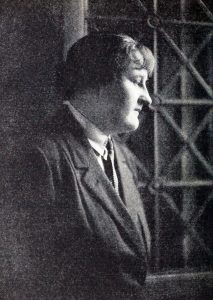← News Archive
“So many of the debates we’re having today were actually settled 100 years ago”: A Conversation with Shelley Stamp
Following the success of the Blu-ray/DVD box set Pioneers of African-American Cinema, Kino Lorber is producing Pioneers: First Women Filmmakers, which will present work by early American women filmmakers. The set is curated by film historian (and WFPP contributor) Shelley Stamp. To celebrate this upcoming release and highlight titles in the collection, Brooklyn Academy of Music, in collaboration with Kino Lorber, is presenting a corresponding film series from July 20-26, 2018. Stamp will introduce the first four programs, including work by Alice Guy Blaché, Lois Weber, and Nell Shipman.
In advance of the film series, Kate Saccone recently discussed the upcoming Blu-ray/DVD release with Shelley Stamp.
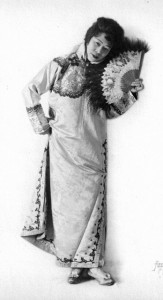
Marion E. Wong.
First off, can you talk a little bit about the upcoming Kino Lorber release? How many films will be included? What was your curatorial framework?
The Kino-Lorber collection, Pioneers: First Women Filmmakers, will be a 6-disk set showcasing work by 19 different early American filmmakers, including (at last count) 14 features and close to 40 shorts. We’ve also included some incomplete works and film fragments to try and give the full picture of women’s filmmaking during this period. Much of this work has not been available before.
I wanted the collection to be as broad as possible, so it contains not only commercial cinema, but also amateur movies by Angela Murray Gibson and ethnographic films by Zora Neale Hurston. It also features work by women working in a range of production contexts–Hollywood, obviously, but also Marion E. Wong, based in Oakland, California, and Nell Shipman, based in remote Priest Lake, Idaho. We interpreted the term “female filmmaker” fairly broadly to include women who might not have been officially credited as “director” but who were clearly the primary creative force behind their productions–so these include Dorothy Davenport Reid’s work on The Red Kimona and Alla Nazimova’s work on Salomé.
The films will be presented in 4K and 2K restorations with newly commissioned scores (most by female composers), audio commentary by a range of experts, a documentary featurette, and a booklet essay. Producer Bret Wood, who also produced the stunning collection, Pioneers of African American Cinema, has done another stellar job pulling this all together in conjunction with partners like the Library of Congress and the Women’s Film Preservation Fund at the New York Women in Film and Television.
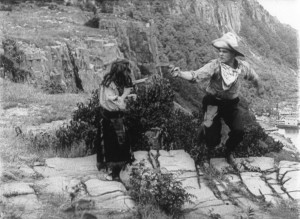
Frame enlargement, Two Little Rangers (Solax, 1912)
Your latest book Lois Weber in Early Hollywood has contributed so much to the rediscovery of Weber. Did you make any personal discoveries about other female film pioneers while working on this release? Were there any surprises?
Even I was surprised by the sheer volume of work made by women in the early decades of filmmaking, the overall quality of this work, and its variety. I’d spent so long immersed in Weber’s work, and so long trumpeting her astonishing output, that I had lost touch with the extraordinary work done by so many of her contemporaries. In putting together this broader collection I have been so lucky to benefit from advice from other experts who helped steer me in the right direction, like curator extraordinaire Mariann Lewinsky and Alison McMahon who gave me great advice about Alice Guy Blaché titles, and, of course, you and Jane Gaines at the Women Film Pioneers Project.
Were there any titles that you loved but could not include in the Kino release for whatever reason?
Yes! My two great disappointments were not being able to include Dorothy Arzner’s Get Your Man, starring Clara Bow, and Lois Weber’s Sensation Seekers, starring Billie Dove, both made in 1927. Each offers an incredible–and very different–take on Jazz Age flapper culture. Get Your Man played at last year’s San Francisco Silent Film Festival–and the crowd I saw it with went wild. Sensation Seekers played at this year’s Toronto Silent Film Festival. I wasn’t there to see the crowd reaction, but heard that it too was extremely popular with audiences. So I’m hopeful that each might get a stand-alone release in the future.
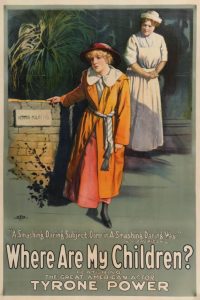
Poster for Where Are My Children?
What are the challenges and rewards of programming silent films outside of the academic context?
There’s really nothing but rewards, from my point of view. In my experience, audiences respond really well to silent cinema–if you’ve got beautiful prints and great musical accompaniment. I say this as someone who’s been teaching silent cinema for years–my students are routinely blown away by films like Where Are My Children?, Within Our Gates and Man with a Movie Camera–and also someone who regularly attends the San Francisco Silent Film Festival, where the magnificent 1,400-seat Castro Theater in often packed with crowds laughing, cheering and loving silent movies. I think the audiences at BAM will be similarly appreciative–all the more so because of the incredible work we’re showcasing by female filmmakers who have been so unjustly neglected in film history.
In your recent episode of The Cinephiliacs podcast, you said that “it’s really clear that women make different kinds of films, 100 years ago and now.” I think the lineup for the series at BAM really reflects this in terms of the diversity of genres, filmmaking styles, topics, and behind-the-scene roles. Is there anything else that you hope that this film series and box set will emphasize about women’s involvement in early cinema?
One of the most important messages I hope to convey is that so many of the debates we’re having today were actually settled 100 years ago–Can women direct action pictures? Yes. Can female leads carry pictures at the box office? Yes. Can “women’s issues” (like reproductive politics, sexuality, family life) appeal to a wide audience? Yes. Ignoring this history and continuing to debate issues that were settled so long ago makes today’s generation of female filmmakers think they have to reinvent the wheel, when all they really have to do is look to the past for inspiration.
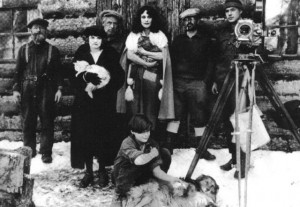
Nell Shipman (center) and team.

